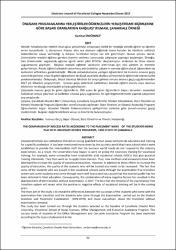ÖNLİSANS PROGRAMLARINA YERLEŞTİRİLEN ÖĞRENCİLERİN YERLEŞTİRİLME BİÇİMLERİNE GÖRE BAŞARI ORANLARININ KARŞILAŞTIRILMASI, ÇANAKKALE ÖRNEĞİ
Abstract
MeslekYüksekokulları nitelikli insan gücü yetiştirmeyi amaçlayan, belirli bir mesleğeyönelik eğitim ve öğretim veren kurumlardır. İş dünyasının ihtiyacı olan araelemanı sağlamak üzere kurulan bu okulların sektörün beklentilerine cevapvermediği, iş dünyası tarafından birçok kez dile getirilmiştir. Bunun sonucuolarak, Üniversiteler mesleki eğitime gereken önemin verilmesi konusundaçalışmalar yapmaya başlamıştır. Örneğin, bazı Üniversiteler uygulamalı eğitimeağırlık veren pilot MYO’lar oluşturmuştur. Ardından da three masteruygulamasına geçmiştir.  Böylece meslekieğitimin kalitesinin arttırılması için yeni yöntem ve metotlargeliştirilmiştir. Ancak, eğitim kalitesinin arttırılması yönündeki bu çabalarınyanında eğitim alacak öğrencilerin de kalitesinin arttırılması gerekmektedir.  Meslek yüksekokullarına yerleşen öğrencilerinbir kısmının sınavsız geçiş sistemi ile gelmesi, sınav ile gelen öğrencilerinde düşük puanlarla okullara yerleşmesi ile eğitiminde istenen kaliteyakalanamamıştır. Dolayısıyla, birçok olumsuz faktörün bir araya gelmesi sonucusınavsız geçiş uygulamasından 2017 yılı itibariyle vazgeçilmiştir.  Sınavsız geçiş sisteminin kaldırılmasıMesleki eğitimi olumlu veya olumsuz etkilerinin ne olacağı önümüzdeki yıllardagörülecektir.Çalışmada sınavsızgeçiş ile gelen öğrencilerle, ÖSS sınavı ile gelen öğrencilerin başarıdurumları arasındaki farklılıkları ortaya çıkarmak ve kaldırılan sınavsız geçişuygulaması ile ilgili değerlendirmeler yapmak çalışmanın ana amaçlarıdır.Çalışma, Çanakkale Onsekiz MartÜniversitesi, Çanakkale Sosyal Bilimler Meslek Yüksekokulu, Büro Yönetimi veYönetici Asistanlığı Programı öğrencileri temel alınarak yapılmıştır. BüroYönetimi ve Yönetici Asistanlığı Programı öğrencilerinin başarı düzeyleriMeslek Yüksekokullarına yerleştirilme türlerine göre (sınavlı-sınavsız geçiş)incelenmiştir. Bulgular değerlendirilerek sonuç ve önerilerde bulunulmuştur. Vocational Schools are institutions that aim at raising qualified human power and provide education and training for a specific profession. It has been mentioned many times by the business world that these schools which were established to provide the intermediate staff that the business world needs do not respond to the industry expectations. As a result, the Universities have begun to work on giving the necessary training for vocational training. For example, some universities have created the pilot vocational schools (VOCs) that give practical training intensively. They then went on to apply three masters. Thus, new methods and innovations have been developed to increase the quality of vocational education. However, in addition to these efforts to increase the quality of education, the quality of the students who will be trained also needs to be increased.  The fact that some of the students who are placed in the vocational schools come through the examination-free transition system and some students who come through exam with low scores has caused that the desired quality has not been obtained in their education. Consequently, the combination of many negative factors has resulted in the abandonment of the transition without examination in 2017. The fact that the removal of the examination-free transition system will reveal what the positive or negative effects of vocational training will be in the coming years.The main aim of the study is to reveal the differences between the successes of the students who come with the examination-free transition and the students who come through the Examination  carried out by the Student Selection and Placement Examination  (SSPE-OSYS) and make evaluations about the transition without examination removed.The study has been carried out through the students selected as the baseline of Çanakkale Onsekiz Mart University, Vocational School of Social Sciences, Office Management and Executive Assistance Program. The success levels of students of the Office Management and Executive Assistance Program has been examined according to the types of placement in theVocational Schools (with or without examination transition). Findings have been evaluated and conclusions and suggestions have been made.
Source
Ejovoc (Electronic Journal of Vocational Colleges)Volume
7Issue
2URI
https://dergipark.org.tr/tr/pub/ejovoc/issue/36676/417548https://dergipark.org.tr/tr/download/article-file/461562
https://hdl.handle.net/20.500.11857/3918
Collections
- Makale Koleksiyonu [335]



















